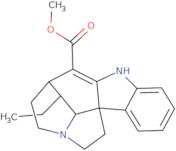
Información del producto
- (+)-19,20-Dihydrocondylocarpine
- (+)-Tubotaiwine
- (20S)-19,20-Dihydrocondylocarpine
- 20(S)-Tubotaiwine
- 3,5-Ethano-3H-pyrrolo[2,3-d]carbazole-6-carboxylic acid, 4-ethyl-1,2,3a,4,5,7-hexahydro-, methyl ester, (3S,3aR,4S,5S,11bS)-
- 3,5-Ethano-3H-pyrrolo[2,3-d]carbazole-6-carboxylic acid, 4-ethyl-1,2,3a,4,5,7-hexahydro-, methyl ester, [3aR-(3aα,4β,5β,11bS*)]-
- 3,5-ethano-3H-pyrrolo[2,3-d]carbazole-6-carboxylic acid, 4-ethyl-1,2,3a,4,5,7-hexahydro-, methyl ester, (3aR,4S,5S,11bS)-
- Condyfolan-16-carboxylic acid, 2,16-didehydro-, methyl ester, (14S)-
- Methyl (14β)-2,16-didehydrocondyfolan-16-carboxylate
- Methyl (1S,11S,17R,18S)-18-ethyl-8,14-diazapentacyclo[9.5.2.0~1,9~.0~2,7~.0~14,17~]octadeca-2,4,6,9-tetraene-10-carboxylate
- Ver más sinónimos
- NSC 306222
- Tubotaiwin
- Tubotaiwine (8CI)
Tubotaiwine is a n-oxide alkaloidal extract from the plant Tubocarpus sp. It has been used as a folk medicine for hypertension and leishmaniasis, and to treat diarrhea. The chemical reactions of tubotaiwine are not well understood, but it has been shown that tubotaiwine has a high content of fatty acids and monoterpenoid indole alkaloids. Tubotaiwine also possesses anti-inflammatory properties. Chemical analyses have revealed that tubotaiwine contains phenolic compounds (e.g., flavonoids) with antioxidant activity. Tubotaiwine can be used in low light conditions where other plants cannot grow; this may be due to its ability to convert light energy into chemical energy via photosynthesis or its ability to store solar energy in the form of starch or lipids. The chemical composition of tubotaiwine is similar to those found in plants such as Apocynaceae and Leishmania, which
Propiedades químicas
Consulta técnica sobre: 3D-GAA71169 Tubotaiwine
Si desea solicitar un presupuesto o realizar un pedido, por favor añada los productos deseados a su carrito y solicite un presupuesto o pedido desde el carrito. Es más rápido, más barato, y podrá beneficiarse de los descuentos y las ventajas disponibles.





